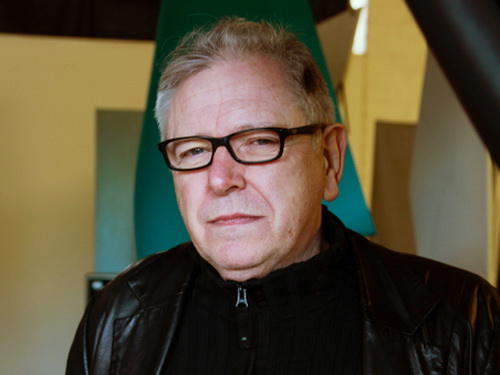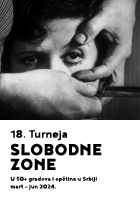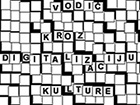David Elliott on 56th October Salon in Belgrade

British curator David Elliott, Artistic Director of the 56th October Salon in Belgrade, which will be held in autumn of 2016, after last year's break, talks in an interview with SEEcult.org on topic “The Pleasure of Love” and reasons for choosing this particular concept, regional and world wide artist scene, mental continuation of the old Cold War division between East and West, market logic often opposed to talent and quality...
- You have thought of the 56th October Salon as a “distant relative” of the first Autumn Salon in Paris 1903, with a goal to make it possible for less internationally affirmed artists to exhibit along with their already renowned colleagues. Can you compare the circumstances of the early 20th century and today, in terms of opportunities for artists to present themselves at the international and at the national level as well? What are the main similarities and differences? Do you think that today's art establishment has an ear for all artists alike?
D.E: I think that the situation today is very different from that of the early years of the twentieth century but the mix of putting together "established" with "emerging artists" still can work. Of course today there are many different digital or virtual platforms on which artists can show the work but I don’t think that any of these replace the analogue quality of actually going to an exhibition an exhibition and the visitors’ direct experience of seeing art in a carefully modulated configuration – and of course talking afterwards about their shared experience.
- The propositions of the open call for the 56th OS stating that only artists who are less than 40 years old can participate have encountered disapproval in artistic circles in Serbia, given that those who are older than 40 had little chance to participate in international exhibitions in the past fifteen years. What are the reasons for this age limit?
D.E: In my discussions with the Board of the Salon one of their main criticisms of some previous shows was their view that that the same (or same kind of artists) always get shown. I thought that this would be a good way of opening thing up to artists who had not yet had so much exposure.
- To what extent does the success of an artist today depend on talent, and on the other side, how much does it depend on promotion skills, acquaintances with the curators, collectors, gallerists etc?
D.E: Of course there is a lot of hype in the art world as well as a lack of willingness to look beyond the market base so there’s a real danger of the whole system being a self-fulfilling prophesy. If Serbian collectors should start taking their own contemporary art seriously I am sure that both artists and the market would respond to this and that some kind of virtuous circle would be created and then others may then join in. But even then, in terms of a market, Serbia is a small base and for modern and contemporary art one has to think regionally and internationally because that is largely how the art developed historically.
But the market should never be regarded as an arbiter of quality although it may reflect particular points of view about taste. The market in art, as in anything else, is purely a mechanism designed around price and desire rather than around any broader idea of worth or value although such considerations may well have an impact on desire. For me, an artist’s talent and the quality of a particular work are absolutely fundamental and many artists can make good works without having a significant place in the market.
- Can you explain the topic of the 56th OS “Pleasures of love" in more detail, and what do you think is the significance of emotions in contemporary art? Is it possible to create art without emotion?
D.E: For me the idea of emotion in art is attractively, and maybe a little perversely, old fashioned at a time when artists are supposed to be so cool, theoretical and strategic. It’s an antidote to the fact that many artists create works cynically in ways they believe will be approved by others or to gain attention in the market rather than finding their own path. I would like to inject a note of "innocence" into this exhibition and stimulate a general discourse about art that favours works that are regarded as absolutely necessary by those who make them. This sense of necessity revolves not only around the artists’ personal volition but also is dependent upon an awareness of the time and place in which they live. And, if the work is any good, this will be easily communicated to others. I am not writing an open cheque here for a spurge of romanticism: emotion may be expressed in art in many different ways and it will not be restricted only to love (which would be horribly corny) and this has been made clear in the description of the exhibition. By concentrating on emotion I am considering the human condition – spiritually, existentially, morally and metaphysically – and why and how artists express it. I am imposing no limit, but I believe that empathy is central to the rich expressive possibilities of art in whatever form.
- You are considered a great connoisseur of Soviet and Russian avant-garde, modern and contemporary Asian art. Also, you worked with Bojana Pejic on exhibition "After the Wall: Art and culture in post-Communist Europe," which premiered at the Moderna Museet in Stockholm, and was one of the first major studies of post-communist art. Is art in this region still viewed primarily from the perspective of the specific historical circumstances?
D.E: Everywhere has its own cultural traditions. British art is part of a larger European tradition yet it has many features that are particular to it – some climactic, some ideological and so on….. In the contemporary field to a large extent we seem all the same – but, if you look hard, there are also many telling differences. We all have to come from somewhere, and this affects how we see the world and express it. I am disappointed that on the "western" side there still seems to be a mental continuation of the old Cold War division between East and West. I think that this is because not so many curators from the West are prepared, or able, to travel to see what is happening – or maybe they are just not curious enough. Of course, previous instabilities in the region have not helped.
- In which ways are you familiar with recent art production in this region?
D.E: I know personally many artists, museum directors and curators from the region and try to keep abreast of the main developments and I will work hard to catch up to the present for this exhibition.
- It was announced that about 50 artists from approximately 50 countries will be selected on the basis of a contest to participate in 56th OS. Which will be your criteria for the selection of artists, considering that the text of the competition in general stated that they must suit the theme and the concept of 56th OS, which can also be broadly interpreted?
D.E: The two main interlocked criteria are quality of work and relevance to the broad theme of the exhibition. Important also are the spaces in which the exhibition will be shown as a synergy between the works and where they are displayed is important to me. The other (probably limiting) factor, of course, is budget.
- The October Salon was not held this year for the first time, and its transformation into a biennial exhibition and the way it was done caused a severe reaction on the art scene and wider culture scene as well. Have these circumstances affected your decision to accept the invitation to be the curator of 56th OS and how would you describe cooperation with the new Board of the OS?
D.E: I was not really aware of the detail behind these decisions so they did not affect me. My only interest in deciding to take on this task is to make as beautiful and memorable exhibition as possible.
David Elliott is a curator, writer and professor of modern and contemporary art who has directed museums in Oxford, Stockholm, Tokyo, and Istanbul. During 2014 he was Artistic Director of A Time for Dreams, the IV International Moscow Biennale of Young Art, co-curator of Pandamonium: New Media Art from Shanghai and Fragments of Empire at Momentum in Berlin and curator of Art From Elsewhere. Art from British Regional Galleries, a Hayward Gallery Touring Exhibition.
He is currently Chairman of the Board of Triangle Art Network/Gasworks in London, Chairman of the Advisory Board of Momentum in Berlin and a Visiting Professor in Curatorship at the Chinese University in Hong Kong.
A specialist in Soviet and Russian avant-garde, as well as in modern and contemporary Asian art, he has published widely in these fields as well as on many other aspects of contemporary art. In 2008-10 he was Artistic Director of the 17th Biennale of Sydney and in 2011-12 directed the inaugural International Biennale of Contemporary Art in Kyiv. His exhibitions Fragments of Empire and Art From Elsewhere are travelling in the US, China and the UK during 2015-17. During the second half of 2015 his exhibitions Scheisse: a solo show by Zhou Xiaohu and BALAGAN!!! Contemporary Art from the Former Soviet Union and Other Mythical Places were running in Berlin and Shen Shaomin There Is No Problem opened in Guangzhou, China in December.
During 2016 Elliott’s new book Art and Trousers: Tradition and Modernity in Contemporary Asian Art will be published by AAP.
Vesna Milosavljević (SEEcult.org)

















